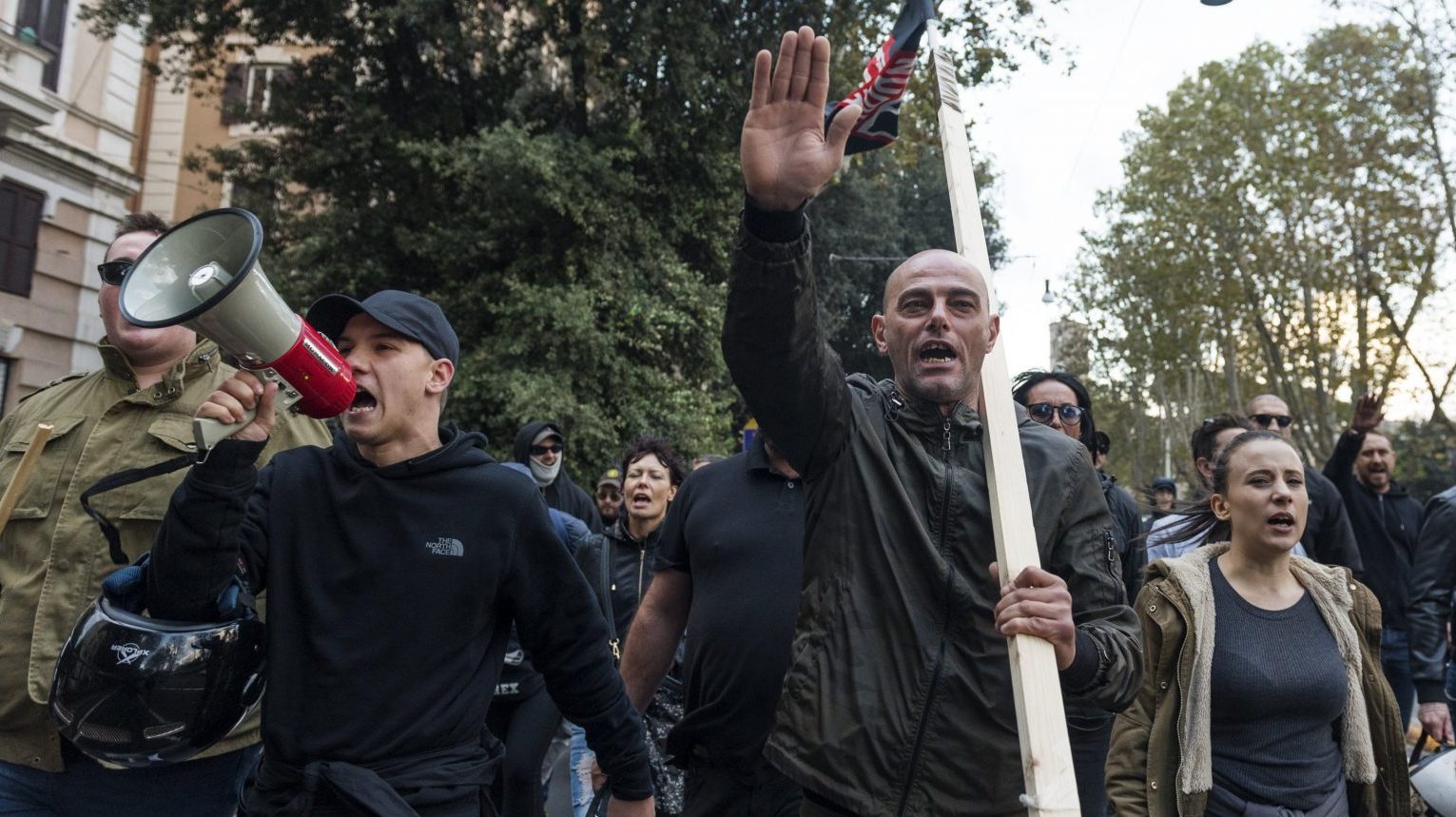This month, uniformed activists from the Polish far right group Bydgoskie Kamractwo Rodaków entered an orphanage to demand it stop vaccinating children against Covid-19. The group’s website promised to stage a “Nuremberg Trial” of the staff, with one activist threatening: “We will take care of you personally: first the director, then the other carers”.
In Germany, flood victims in North Rhine-Westphalia were astonished to find far right activists from the Querdenker movement turning up to provide aid in fake official vehicles, and even fake uniforms, on the grounds that the German state effort had “failed”, in the process making false claims about the official effort via megaphone.
In Britain, meanwhile, the Home Office was forced to reveal that, in the first six months of 2021, refugees housed in abandoned army barracks had been subjected to 70 racist attacks by far right activists, ranging from fireworks to rape threats. Far right group Britain First regularly targets hostels and run-down hotels where those crossing the channel are accommodated, proudly posting videos as its activists verbally harass the guests.
For fascism, in short, all crises are an opportunity. But the multiple crises we are living through are allowing the far right to break through political barriers that the mainstream has relied on for more than 20 years.
In the standard typologies of political science, fascism and right wing populism are different things. The European Commission handbook on radicalisation says that radical populism is committed to democracy but wants to overthrow the elites, while fascism is violent and wants to smash democracy.
The nationalism of the populists is primarily cultural; that of fascists ethnocentric; the typical target of the former is Islam; that of the latter all non-white ethnicities.
Armed with this typology, politicians and commentators of the liberal centre told themselves that populist parties like the AfD, the Sweden Democrats, Rassemblement National and UKIP could – with their electoral support stuck on low double digits – act as a firewall against the return of real fascism.
Unfortunately, the opposite has happened: the firewall is on fire. From Trump’s Republican Party to the German AfD, the ideologies followed by right wing populist voters are morphing rapidly in the direction of fascism.
Over the past five years, the casual prejudices in the heads of right wing populist activists have become theorised and systematised around the new thought-architecture of fascism. I first noticed this during the Brexit crisis of September 2019, when supporters of the jailed far right activist Tommy Robinson (Stephen Yaxley-Lennon) marched down Whitehall to disrupt a pro-Remain rally, chanting Boris Johnson’s name.
These were working class men and women in their 50s and 60s, mobilised initially around Islamophobia and then “getting Brexit done”. Now, for the first time in many encounters, I realised they were not just screaming at me, but about me. “Paul Mason. Marxist”, one woman shouted into my camera. “We’ve researched you. You’re a traitor to your country.” As the police ushered her away, I can remember her finger still jabbing towards me: “Marxist, Marxist.”
Something has changed on the far right. Via the anti-mask and lockdown movements, the anti-vaccination movement, the QAnon conspiracy theory and – most recently in Britain – the movement against footballers “taking the knee”, they have learned a new, more rigorous ideology. It goes way beyond the “racism, nationalism, xenophobia and the strong state” checklist the European Commission adapted from political science.
In How To Stop Fascism, I’ve distilled the thought architecture of modern fascism into five concepts. The first is “white genocide”, as summarised by Renaud Camus in The Great Replacement: the assertion that inward migration to Europe is a form of genocide against the white race.
The second tenet flows from the first: the facilitators of “white genocide” are feminism, which depresses the birth rate, human rights legislation, liberalism and indeed democracy itself. Consequently the new far right, and the newly radicalised right wing populism is conceptually at war with all the products of the Enlightenment.

Third, for the new far right, each of these ideologies is, in fact, a covert form of Marxism. The Cultural Marxism theory, borrowed from US paleoconservatism, says that all forms of social liberalism are part of a conscious plot hatched by the Frankfurt School after the failure of the traditional proletariat to take power.
The fourth tenet of the far right thought system is metapolitics. There is no intent, among today’s uniformed and violent far right, to stage a 1920s-style march on Rome, Munich or anywhere else.
They are content, for now, to see right wing populists like Trump, Orbán, Marine Le Pen or Boris Johnson in power. Their function is to place a high overhead cost on removing such people from power democratically, through street violence. Their active focus, meanwhile, is on the kind of symbolic violence I document in the book: harassing migrant hostels to dramatise the situation and stigmatise the occupants; terrorising orphanages and clinics; or storming parliament – whether symbolically, as with the Bundestag, or for real as on January 6 in Washington DC.
Finally, and this is what for me still delineates fascism from right wing populism, they fantasise about a “Day X” – a catastrophic moment where, either because of a refugee crisis like 2015, or an uprising of Muslim minorities in Europe, or black people in America, or because of a climate emergency – western society collapses into an ethnic civil war.
The convergence of radicalised conservatives, existing populists and actual fascists around this belief system gathered pace in the back half of the 2010s – as evidenced by Trump’s reaction to the Charlottesville riot, and by the designation of the Flugel wing of the AfD as extremist by the German police unit BfV. But the Covid-19 pandemic, and Trump’s overt encouragement of the QAnon conspiracy, gave the process massive impetus.
Thus, while commentators of the mainstream, such as the FT’s Gideon Rachman, congratulate European democracies on their ability to “absorb” the right wing populist parties, the nature of the threat has changed, and rapidly.
The threat comes neither from the small fascist groups, nor even the established right wing populist parties. It comes from the rapid radicalisation of their supporters, via online networks, around extreme demands, anti-science and fantasies of genocide.
When we speak of the far right we are no longer dealing with a tribute band to Nazism, Falangism or Mussolini – though such formations still exist. We are dealing with an ideology that is co-created by its participants online; which communicates memetically, through irony, subtext and whose followers teach each other flagrant indifference to the facts.
It has learned to exploit its willing facilitators, the social media giants. Their algorithms and anonymity systems allow far right activists to construct their shared ideology collaboratively, bolting on new conspiracies and new lies.
Maurice Bardeche, the French Nazi collaborator who spent his life denying the Holocaust, predicted in 1961 that “with another name, another face, and with nothing which betrays the projection from the past, with the form of a child we do not recognise and the head of a young Medusa, the Order of Sparta will be reborn”.
Not until we saw the trendy Identitarians of Austria massing at the Greek border to repel refugees, or the Boogaloo Bois take to the streets armed, wearing Hawaiian shirts, to oppose Black Lives Matter, could we know what “a child we do not recognise” might look like.
Fascism has been regrown from its philosophical root-stock: Nietzschean anti-rationalism, Houston Stewart Chamberlain’s scientific racism and the power-worship of Carl Schmitt. It is much better adapted to the networked and globalised environment than the nostalgia-based fascism of the late 20th century.
Anti-science, anti-universalism and anti-democracy form the solid ideological core of this new belief system – and as the historian Ernst Nolte once said of Nazism itself – it is staggeringly internally coherent, despite its detachment of reality.
To resist the new far right we are going to need more than the combination of law enforcement, protest movements and monitoring groups we have today.
Since their chosen form of government at this stage is the right wing populist demagogue, hollowing out democracy while creating space for symbolic violence, we need new electoral tactics to keep such figures out of office.
Hannah Arendt described Nazism perfectly when she dubbed it “the temporary alliance of the elite and the mob”. The only thing that ever defeated it was a temporary alliance of the centre and the left, in the form of the Popular Front governments elected in Spain and France in the first half of 1936.
Today, one of the first tenets of political education on the left is that the Popular Fronts were a disaster. They fell apart. They sold out the French strike wave and suppressed the peasant communes in France. Yes, they did all that, but – for a few crucial years – they suppressed fascism. Leon Blum’s government, including socialists and liberals and with the support of the powerful French Communist Party (PCF) outlawed the fascist Croix de Feu, and carried out sweeping social and economic reforms that attacked the source of the discontent French fascism was feeding off.
The Spanish Popular Front eked out a marginal electoral victory over a united right wing list in February 1936. Its victory triggered a civil war five months later – but had the electoral alliance of the left and centre failed, they would have started that war out of government, not in control of it. But the Popular Fronts were more than simple electoral agreements. The French Popular Front at local level had some of the features we recognise today as a “directed networked movement”: its local branches were out of the control of its constituent parties, and emanated vital cultural influence into the deepest layers of society.
In truth, we’ve already experienced the first modern Popular Front: it was born the moment Bernie Sanders conceded to Joe Biden, halfway through the Democratic primary process.
The deal was private, not public, but it was real: Biden recognised that “moderate Republicans” did not exist in large enough numbers to warrant the suppression of social and racial justice narratives in the Democratic campaign. Instead, he embraced a strategy to mobilise the radicalised plebeian base, with left Congresspeople like Alexandria Ocasio-Cortez, and state-level leaders like Stacey Abrams in Georgia setting the pace.
In Europe, it’s going to look different according to each electoral system. In some countries, there is too little far right threat to need a formal alliance of the left and centre. In countries like Finland and Sweden (and in the German state of Thuringia) it is going to be vital for conservatives to hold the line against governmental collaboration with right wing populists. In France, next year, it is going to need the active and willing, not passive and grudging collaboration of the left and centre to keep Marine Le Pen out of the Elysee.
On top of electoral alliances, we are going to need stronger laws and stronger regulations on big tech. In 1937 the German-American jurist Karl Loewenstein penned a famous call for “militant democracy” – a determined fightback by the democratic state to exploit the organisational weaknesses of fascism. It means a mindset change: the purpose of a democratic constitution is not to enable fascism but to stop it.
In the 1930s that meant banning uniformed parades and the private ownership of arms, and actively policing the police and armed forces against fascist infiltration. Today it means all that, plus – as in Germany – the criminalisation of ethnic libel, genocide incitement and of specific named parties which exhibit Nazi characteristics, not just far right terror groups.
In addition, we need to force big tech to stop facilitating fascism. We should force firms like Facebook, YouTube and Twitter to publish (or at least reveal) how their algorithms prioritise politicised content. The EU should reclassify social media platforms as publishers, and subject their content to existing media law, so that they are liable for any incitement, libel or genocidal ideation carried on their platforms.
These, by the liberal standards of the first 13 years of social media, will sound like draconian measures. But I’ve become convinced that the risks are too great to justify complacency.
Five hundred people escaped from the Majdanek death camp near Lublin, Poland. Nobody would escape a facility built for the same purpose today. Nor does there exist a stable American democracy or an anti-fascist Red Army to do the liberating. As with all major risks, the response has to be shaped not just by the likelihood of the event, but the magnitude of the impact should it occur.
If you believe that Trump, Bolsonaro, Orban, Duterte, Erdogan and Modi are not some kind of historical blip, but pointers towards the possibility of extreme democratic decay, and a second fascist era, it is prudent to arm
the surviving democracies with much more effective weapons of self-defence.
How To Stop Fascism: History, Ideology, Resistance by Paul Mason is published on August 26 by Allen Lane




